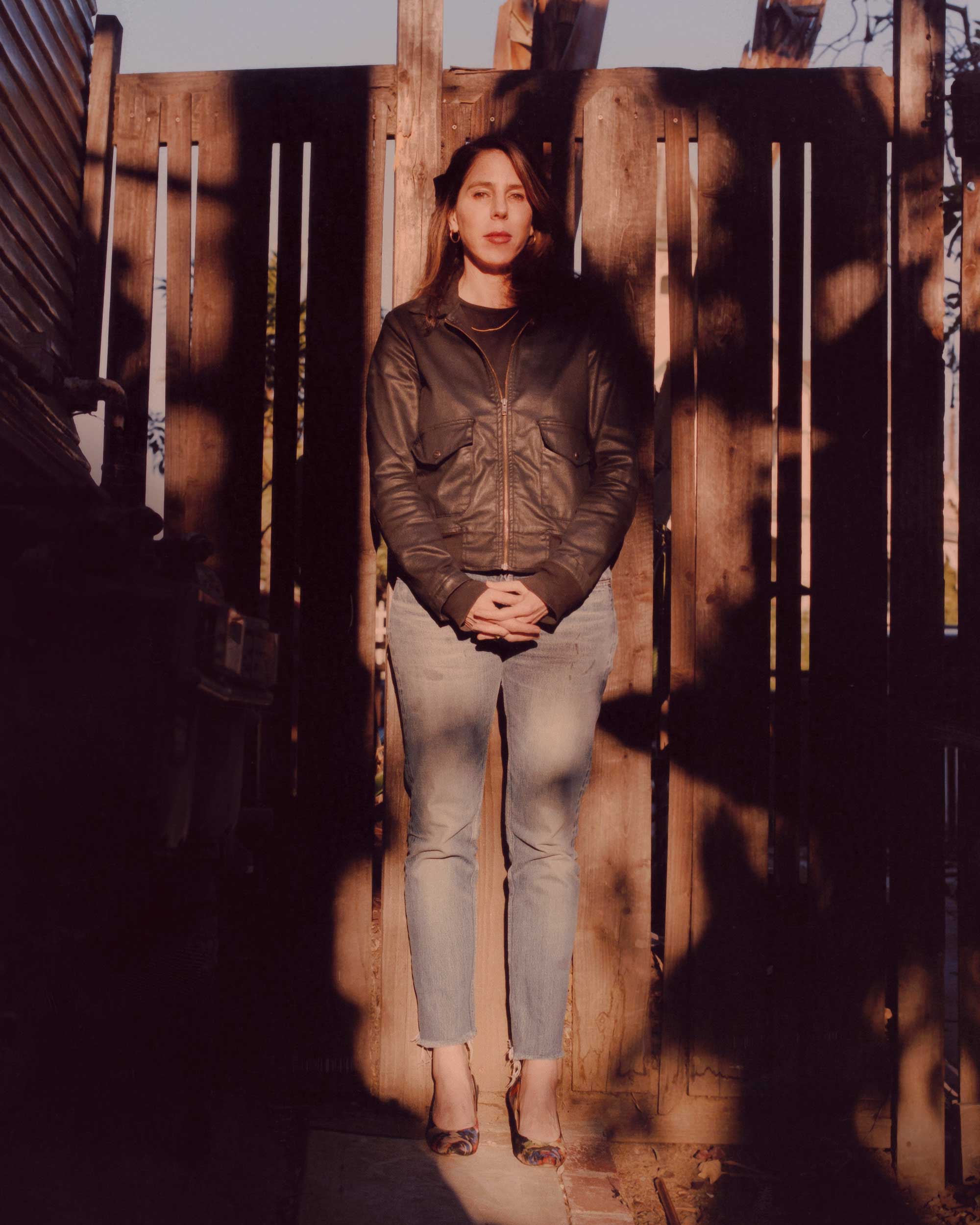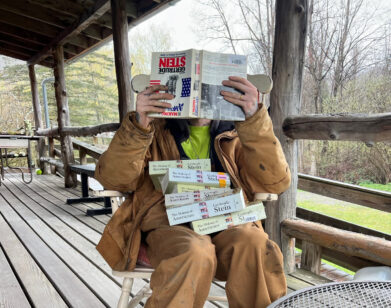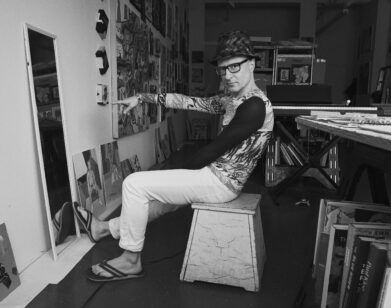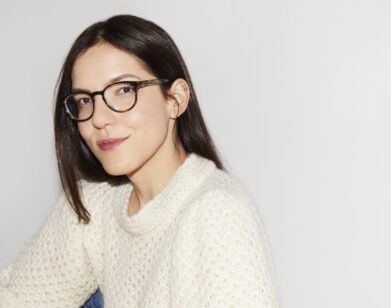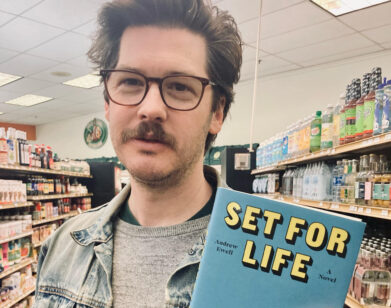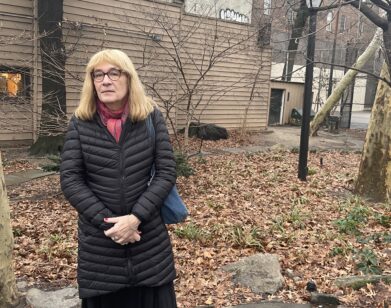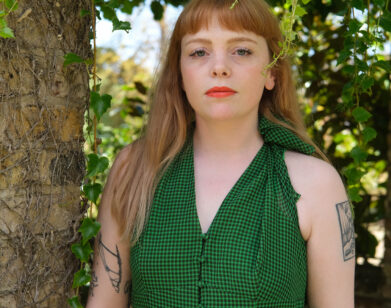literature
Rachel Kushner and Laura Owens on the Power of Reinvention Through Writing
“The person who writes about her experience is not the same person who had the experience,” Rachel Kushner asserts in a recent essay on her time as a young adult hanging out on Market Street in San Francisco. “The ability to write about it is proof of change, of great distance.” Kushner, the Los Angeles–based author behind some of this young century’s most compelling and contemplative novels, including 2013’s The Flamethrowers (contemporary art, 1970s New York, the Italian radical left) and 2018’s The Mars Room (women’s prison), is best known for her fiction. Often enough as it is, readers erroneously assume a fictional protagonist is simply a proxy for the writer behind the curtain. But Kushner is tackling a more remarkable facet of identity confusion in this essay: that even the “I” of a personal essay isn’t a stable, single entity. The person at the keyboard is not the character on the page, moving and thinking and often reflecting on their shared biography. Kushner is correct, of course; we transform minute by minute, grow, evolve, die, change our minds, fall into doubt, start over. But she seems to be telling us that the act of writing itself works as a kind of personal laboratory of endless reinvention. “In writing things down,” Kushner says of the writer, “she is reborn.”
This spring marks the release of The Hard Crowd, a collection of Kushner’s essays from the past 20 years. The subjects range from a hardcore motorcycle race through Mexico to the radical life of the Brazilian writer Clarice Lispector, from Italian cinema to working as an underage cocktail waitress at a club where rock heroes trashed the stage nightly. At 52, Kushner proves as shrewd and daring in her essays as she is in her fiction, and a reader gets the same sense of tagging along with an author who has slept rough, thought hard, and gotten into her car to drive out and witness an event with her own two eyes. On the cover of The Hard Crowd, Kushner poses in front of her ‘64 Ford Galaxie 500 two-door hard-top coupe, the California license plate visible behind her legs. It seems to be a sly homage to that 20th-century god of the personal essay, Joan Didion, specifically of the 1968 Julian Wasser photograph of the writer standing in her Hollywood driveway in front of her Chevrolet Stingray. Kushner has often been considered an heir to Didion, but, in my mind, West Coast leanings aside, she seems to be more aligned to a different writing icon of that same period, Renata Adler, through their shared interest in film, contemporary art, and philosophy. That said, the voice in this dazzling collection is distinctly Kushner’s own. When she writes about the first album she bought at age 9—Blondie’s Parallel Lines—she describes studying the photograph of Debbie Harry on the cover so intently that, “I thought my own far-off adolescence was going to manifest as a result of the hard work of concentrating on beauty as if it were a vanishing point.”
Kushner first met her good friend, the painter Laura Owens, more than two decades ago in Los Angeles. Here, from opposite coasts, they took to Zoom to chat about setting kitchens on fire, running over mattresses, the true meaning of Christmas, and the difference between writing and painting. —CHRISTOPHER BOLLEN
———
RACHEL KUSHNER: I’ve had an eventful day.
LAURA OWENS: What happened?
KUSHNER: The engine in my ’64 Ford caught fire.
OWENS: Is that the car you write about in the book where Remy [Kushner’s 13-year-old child] asks why you don’t have a bigger engine?
KUSHNER: Yes. The same car featured on the book cover that I drive regularly—which you’ve been in. Last week the car wouldn’t start and this mechanic, Luis, came over to try to diagnose the problem. I said, “I think it’s the fuel pump.” And he goes, “Well, let me just see what’ll happen if we prime the carburetor.” He squirted some starter fluid into the top, over the air filter, and asked me to start the car. I did and the air filter and the carburetor caught fire. The real problem was that my car was parked in a garage that people live on top of and I didn’t have a fire extinguisher. It brought back every time I’ve experienced fire in my life, that long moment where things can go in two directions. Luis took off his jacket and snuffed it out, but he punctured his hand and I had to run inside to get him a Band-Aid. At least I still have my car. If there was fuel dumping in the carburetor, it would have been a disaster.
OWEN: I melted my engine once on my first time driving into California. I was in Needles going up that climb right into the desert. I didn’t know that you were supposed to flush your radiator every once in a while. I had a Chevy Cavalier, and halfway up this hill into the desert, I opened the hood. Melted.
KUSHNER: Remember when you drove over a mattress? You could divide the world into two types of people: the type that would panic and swerve around the mattress, or the type that would do what you did, which was just double down and commit to driving over it on the highway going 60 miles an hour.
OWEN: There would have been more chaos in avoiding it because it flew off a truck in front of me and there were too many cars around. I was on the 210 driving back from Vegas. All good.
KUSHNER: The fire this morning reminded me of another moment when I was expecting a fire to catch and burn. When I lived in New York City, I was making toast in my apartment and I didn’t have a toaster so I put the bread in the broiler. I went to my room to write and when I returned to the kitchen, the stove was on fire. The whole kitchen filled up with smoke so thick that you had to go low on the floor to breathe.
OWENS: Was it a grease fire?
KUSHNER: Well, I lived in a fifth-floor walk-up building on the Lower East Side. And I just thought, “Fuck. I’m going to be responsible for some mass death incident on Norfolk Street.” So I went out in the hallway in my nightgown screaming, “Fire, fire!” And my neighbor came bursting out of his apartment with a huge fire extinguisher. He ran into the smoke and flames, and extinguished it. Luckily everybody was fine.
OWEN: Wow.
KUSHNER: But the reason the stove caught fire in the first place was that this guy who’s a friend of my cousin’s was doing some repairs in my apartment. We used to call him Huey Lewis on Crack because he looked just like Huey Lewis, but he smoked a lot of crack. He’d disconnected the stove and put it in the hallway and people had used it as a garbage receptacle. So the oven was crammed full of paper, cardboard, and plastic. So that’s what caught fire.
OWEN: Was that when you were working at Bomb?
KUSHNER: I think I was working at Grand Street. I know it was 1999 because Huey Lewis on Crack was preparing for Y2K. Fully preparing for a total civic breakdown. He wanted me to pay him in cash, so he could drive up to Harlem and buy gold coins. He was burying them at a secret location near the base of the George Washington Bridge. He was burying gold that he would then retrieve after Y2K because he said that all communication was going to break down. The supply chain would collapse and so would all infrastructure.
OWENS: I was busy being a goofball on New Year’s Eve of Y2K. I distinctly remember trying to go play laser tag at Times Square. Were you in New York for Y2K?
KUSHNER: Actually, I was at the bottom of the Grand Canyon. We hiked there for New Year’s Eve. We didn’t think anything was going to happen, but [the late painter] Alex Brown and a bunch of our other friends arranged this backpacking trip. It was really beautiful because the Colorado River runs through there and the rocks of the riverbed are all pink, so the light is, too. It was freezing cold.
OWENS: I’m glad you brought up Alex Brown, because so many of your essays involve art, film, and visual culture. In the last essay, “The Hard Crowd,” you write about this YouTube film of Market Street in San Francisco shot in 1966. It seems that looking at photography and film really stimulates a need in you to write. It’s almost like you want to crawl into the picture and get even closer to it, to go back to a certain moment in time. Does that ring true?
KUSHNER: One of the first pieces of serious fiction I tried to write in my early 20s involved these William Gedney photographs from the 1960s. He took pictures of people in Eastern Kentucky, working on Chevrolets, hanging out, things like that. I wrote these stories to go along with them. I was just experimenting. It seemed a way for me to crack a certain dynamic because these photographs reminded me of my own childhood. People working on cars—there’s a deep connection there. We had this neighbor who had a GTO that was primed with red oxide, and in the rear quarter panel he’d scratched “Vicki’s Toy.” He would haul up and down our street going 100 miles an hour. That piece was called “Vicki’s Toy.” So, yeah, something about these William Gedney photographs manifested the people in my childhood for me. In terms of that YouTube footage of Market Street, it’s just four minutes that I came across quite recently.
OWENS: Would you say watching that footage was like the smell of tea and a madeleine? Did it trigger something in you that focused your attention?
KUSHNER: The thing that’s interesting to me is that it’s a version of San Francisco that is all but gone. I just watched It’s a Wonderful Life the other night. There’s the alternate reality that Jimmy Stewart encounters had he not existed. The town becomes Potterville and all the signs are for gambling parlors, strip clubs, and pawn brokers. And that’s the Market Street that I grew up with and know, and it lives very strongly in my memories. I don’t live in San Francisco anymore, but the primal scenes are durable. No matter what happens later, that’s what you remember. That’s how it looked. Seeing this footage of Market Street back when it was very clean and there were pharmacies and shoe repairs and the theaters that eventually became strip clubs was fascinating to me. You watch this footage of a place and you try to graft your own memory onto it. That version of a wholesome Market Street was probably gone by 1973 when there was a global recession. And now a lot of what I remember is gone, too. But that essay was more about trying to reconstruct my own adolescence through the use of that film. I will say that Potterville, the alternate reality that’s meant to be a hell in It’s a Wonderful Life, is way more interesting than the nice, clean Jimmy Stewart one.
OWENS: It’s funny you bring that movie up. You love Christmas. I fucking hate Christmas.
KUSHNER: I wanted to punch Melania for saying that she doesn’t give a fuck about Christmas. I was so outraged by that.
OWENS: Punch me, too. There’s a part in your Clarice Lispector essay where you talk about how she decorated a Christmas tree in her front yard with dangling irregular geometric shapes in black and gray. Growing up in Norwalk, Ohio, if I were to have put bullshit abstraction on my magnolia tree in the front yard, people would have called me a witch. They would have thought we were Satan worshipers.
KUSHNER: I’m sure that’s why she did it. You know, Jason [Smith, Kushner’ husband] also hates Christmas. I think the reason that I love it is that my mother’s family is German and they have these German Christmas traditions. My aunt puts actual candles on the Christmas tree. But more importantly, my parents were completely untraditional in pretty much every way. They weren’t married. They didn’t celebrate any holidays. We didn’t have any religion. There was not much structure, and also no money. So I was really into Christmas. They would let me get a Christmas tree on Christmas Eve after everything was closed because at that point you could buy a tree for, like, a fifth of the price. My brother and I would go down there and put the tree on his skateboard and bring it home. It almost felt like a form of rebellion to be really into Christmas. It wasn’t being forced upon me. I was seeking it out. Like the economy of desire. You want to want. You don’t want to be told that you have to want.
OWENS: As a kid, I would get picked up by the Sunday school teacher and taken to McDonald’s as a bribe to go to Presbyterian Sunday school. Christmas always devolved into drunk family members shouting at one another and people crying. It was never pleasant. The one thing I do remember was making Christmas cookies for a Christmas bazaar, eating a lot of the batter, and getting physically ill. It was on a Sunday night, and then Monday morning came and I was like, “Mom, I’m really too sick to go to school.” She was a working mom and left me home, and at around 11:00 I remember going to the bathroom and having my first period and being like, “This is why I’m sick. It wasn’t because I was eating raw cookie dough.” And my mom called and she was like, “How are you doing? Are you throwing up?” I was like, “Oh, mom. I had my period.” She said, “Oh, okay. You want me to pick you up and take you to school now?”
KUSHNER: That was her reaction?
OWENS: Yeah.
KUSHNER: No congratulations?
OWENS: She worked for the health department. If you had an STD or thought you were pregnant, she was the one you would go to. She was the woman you would hand your pee over to. At some point, like most girls, I thought perhaps I was pregnant in high school. It was a possibility. I was probably just paranoid. She didn’t know I was having sex. I was like, “I just need to give you my pee to see.” She was like, “But you don’t have sex. How could you be pregnant?” I said, “We had our clothes on and I’m just worried. I think maybe something happened and we definitely had our clothes on so I don’t know.” So she took the pee and she completely believed me. She was in such denial.
KUSHNER: I didn’t actually get my period until I was almost 16 years old, by which point I was moving out of my parent’s house. I left for good at 16. I never came back.
OWENS: I can’t believe you left home at 16.
KUSHNER: There’s nothing special about it. In the 1970s and ’80s, there was this thing of just advancing kids a grade if school was boring. I didn’t need to be advanced a grade. I just needed to be at a school that would give me more than busywork. So I skipped seventh grade and had started a little bit young just because I had a birthday that was late in the year. Plus I was a late bloomer, and really innocent in certain ways, compared to my friends. I remember the first time I went on a date with this guy whose name was actually Chad when I was 11.
OWEN: You went on a formal date when you were 11?
KUSHNER: Well, we hung out together. He lived in the boys’ home on West Portal. The guys everybody dated were the guys who lived at this boys’ home. He asked me if I wanted to hang out with him so we took the bus out to Cliff House and smoked a joint. I really had a crush on him and I overheard my friends talking about it, saying, “Yeah, Chad went on a date with Rachel. He thought she was pretty cool and then she took off her jacket. Ha, ha, ha.”
OWENS: Oh, no.
KUSHNER: And that was the end of it for him, because I took off my jacket and there was just nothing happening. I was flat-chested like a boy. But I look back many, many years hence, and I’m glad I wasn’t the girl that all the boys were jumping on.
OWENS: I grew up in Ohio. And I know you think of yourself as a kid from the Sunset District of San Francisco. But that is not how other people would necessarily see you.
KUSHNER: You’re a kid from Ohio who worked at the dump. I’m a kid from the Sunset who worked at Baskin-Robbins. In a certain way, I didn’t understand the brutality and violence of the Sunset, of the Fighting Irish, until, like, yesterday. Someone from childhood recently started reading The Mars Room, a girl I hadn’t been in touch with in decades, and she said, “Oh my god, you wrote about our lives.” How does a person then answer, when asked, by journalists, “How did you ‘research’ this novel?” If you tell them you lived aspects of it, they can’t hear it, and maybe it’s none of their business. It’s a novel, after all.
OWENS: You open the book with a quote from Clarice Lispector that I really love: “What others get from me is then reflected back onto me, and forms the atmosphere called ‘I.’” In certain social situations, you’re performing certain selves. Is that what you mean?
KUSHNER: You send out a frequency and then it bounces back to you and you’re like, “I’m this frequency.” So you’re even self-reflecting the identity that you’re experiencing of yourself. And even if nobody’s watching, you’re still performing a version of yourself. I think that’s what identity is. Part of it is you practice it and learn how to live it and perform it.
OWENS: You’re convincing yourself of that thing that you’re attempting to inhabit. It’s a survival act in some way.
KUSHNER: Or an act of joy. That’s why it can be so clean to be alone for long periods of time. I like to be alone. I live with two people, Jason and our son, and I like them plenty. But I could be alone for a month and just not speak to or see anyone, and start to feel like I’m really honing in on and developing and refining the different modalities of me that I want to inhabit. But in terms of that quote being an epigraph for the book, I did not choose to put a photo of myself on the cover. That was my editor’s decision. But because it’s there, I was thinking about the mythology of self and the way the self that you aid and abet, if you will, the one that you participate in the construction of, is partly what you’re giving off to other people and what they’re receiving and then bouncing back to you. It’s also about wanting to please other people, always wanting to figure out what they’re seeing when they look at you, and to reflect that thing that they’re seeing back to them to reassure them. So the quote is partly about that.
OWENS: This is a good segue into an idea we started with, which is that some of the people who appear in The Hard Crowd—like Alex Brown or [the tattoo artist] Freddy Corbin—are known for being authentically themselves, and not as celebrities.
KUSHNER: Some of it is probably generational, because, when I was in my 20s, there wasn’t the internet so there wasn’t the same machinery of self-promotion or interest in fame. But also, I was a bohemian. I was not surrounded by people who had actual ambitions. Before I moved to New York, living in San Francisco, few people wanted to actually achieve or do anything with their lives. That would have been considered square. It was much more “live in the moment” that seemed an authentic form of being a real artist, as opposed to trying to make stuff.
OWENS: What about Survival Research Laboratories [a performance art group founded in San Francisco in 1978]? Weren’t they blowing things up around that time?
KUSHNER: Yes. I dated someone who’d built a V-1 rocket they blew up. And they had a kind of celebrity and fame, but most of the people I knew were just happy chilling in their subcultures. Freddy was famous in San Francisco because of tattooing and that was before tattooing was mainstream. I just happened to be his roommate and included that in The Hard Crowd because there was a certain glamour to being in proximity to that kind of cash and fame. They lived this very high life and they had this style like they were mobsters from Las Vegas, with diamonds and beautiful classic cars with custom plates. There would be drugs, girls, people coming and going from the apartment. I had nothing to do with it, really. But people like Alex Brown, yes, I would define as having a kind of star quality or a social fame.
OWENS: I guess I was thinking about people like Alex who connect a lot of different people together, stringing everyone into a constellation. I was recently rereading that Thomas Frank book [The Conquest of Cool] from the ’90s about the idea of how culture gets co-opted by capitalism and there is no subculture anymore. I don’t want to romanticize the ’90s because Taylor Swift’s new album is like a fucking ’90s rehash. Don’t get me wrong. I’ve come around to Taylor.
KUSHNER: I don’t know who that is, honestly.
OWENS: You don’t know who Taylor Swift is?
KUSHNER: Not really. I mean, I just pay attention to what I’m interested in.
OWENS: Okay. Well, she’s a really big pop star right now.
KUSHNER: Yeah, I know that, but I’ve never heard the music.
OWENS: Maybe I’m becoming a fan because I’m being inundated with it by my kids 24/7.
KUSHNER: I live with a child who has no relationship to popular music whatsoever.
OWENS: I have one of those and I have another one who’s not like that.
KUSHNER: I know you do, because my kid and that kid talk about Charles Ives and Stravinsky. But back to what you were saying about Thomas Frank and the argument in The Conquest of Cool that anything rebellious is always going to be recuperated in some manner by the machinery of marketing.
OWENS: Yeah, that.
KUSHNER: I mean, I don’t really feel like I’m concerned so much with coolness as a currency. I’m not quite sure why. I just have my own relationship to my past, and was trying to reconstruct some of that and figure out how it has made me a writer or how it informs my work or when it does and when it doesn’t. That’s what I was interested in exploring more than simply, “Oh, this was really the better and more fun time.” It’s more that every person when you get to a certain age has decades’ worth of built-up experiences that are not explainable, no longer existent in the world around you, and yet continue to speak to you almost as if you’re experiencing your life in the present. You’re this cauldron of memories. And when you find a piece of film footage that seems to turn them on, it’s like the film is proving that these different times and experiences and memories are existing all at once. Time isn’t really synchronous because we’re always partly in the past and I’m very rooted there. The older I get, the more I somehow can’t get out of looking at the past, which is not an unpleasant thing for me. It just is what it is.
OWENS: If I was thinking about the past while I was making paintings, I don’t think I could make one. I have to think that I’m only doing something that’s about the present or the future.
KUSHNER: That could be why you are such an innovative artist. You’re always making the new.
OWENS: I think maybe painting also just has an inherent relationship to the past. The medium itself is located in the past.
KUSHNER: Painting’s got a lot of baggage. Visual art is formally so different from writing in that it has to be on some kind of vanguard trajectory, and it has a very oedipal relationship to the past. Writing’s not like that.
OWENS: I don’t think it’s vanguard, but I think it has to make a proposal for what is happening right now.
KUSHNER: Writing is such a different thing. It’s much more formalized. Innovative things that writers try out, somebody already tried that in the 1920s, which was really a great time for writing. In 1922, T. S. Eliot wrote The Waste Land and Proust’s first volume was published in English and Joyce wrote Ulysses. Writers aren’t bettering that now. I think there’s just something about the way that we read and the way that language works in terms of cadence that is resistant to transformation of the type you’re doing with painting. And maybe that makes it so that thinking about the past can be as radical as anything else in writing.
OWEN: Do you think writing could focus too hard on the present?
KUSHNER: Yes, that’s called The Hot Take. It works in the form of a painting. When I talk to my artist friends, they’re looking at reality right now. If I talk to Seth Price, he can tell me the latest version of some technology that advertisers are using and then inverting it and perverting the usage of that technology and converting it into art. That’s interesting to me. But for writers, to have an immediate reaction to the world around you and produce a text that is derived from that medium, that’s not always going to work. There is a reason why writers wait a while to weigh in. But I think part of that also is standing on the sidelines looking at the field before you, and choosing your moment.
———

